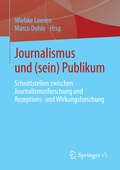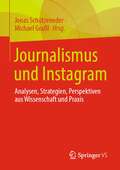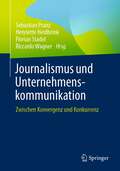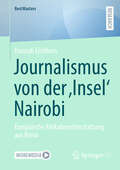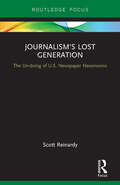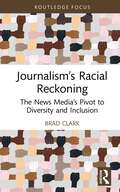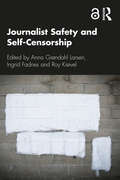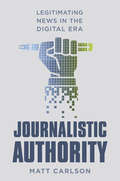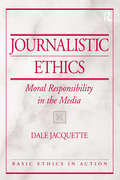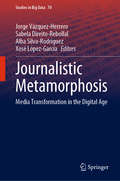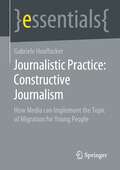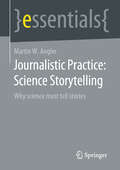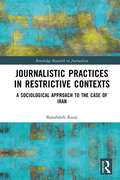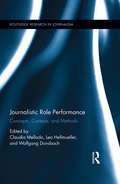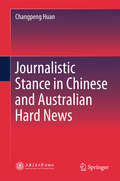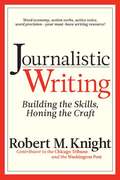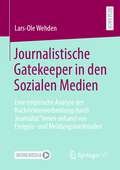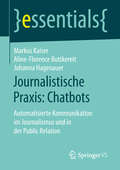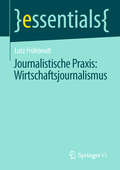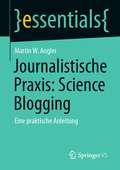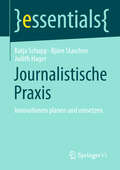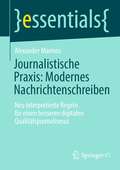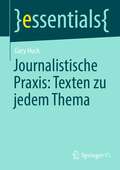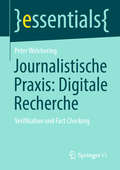- Table View
- List View
Journalismus und (sein) Publikum
by Wiebke Loosen Marco DohleDas Bild von der verschwimmenden Grenze zwischen Kommunikator und Rezipient ist das Leitmotiv zur Charakterisierung der gewandelten Kommunikationsverhältnisse im Onlinezeitalter. Die akademische Trennung zwischen Journalismusforschung und Rezeptions- und Wirkungsforschung erschwert es, die damit verbundenen Entwicklungen und Phänomene adäquat zu beschreiben und zu analysieren. Dieser Band versammelt daher Beiträge, die sich mit den Schnittstellen zwischen Journalismusforschung und Rezeptions- und Wirkungsforschung auseinandersetzten und Theorien, Ansätze und Methoden aus beiden Feldern miteinander abgleichen. Im Mittelpunkt steht dabei die Frage, wie eine derart integrierende Perspektive dazu beitragen kann, die gewandelten gesellschaftlichen Kommunikationsverhältnisse theoretisch und empirisch in den Griff zu bekommen.
Journalismus und Instagram: Analysen, Strategien, Perspektiven aus Wissenschaft und Praxis
by Jonas Schützeneder Michael GraßlInstagram ist auf dem Weg, der wichtigste Social-Media-Kanal der Welt zu werden. Dieser Sammelband geht die Forschungslücke im Zusammenspiel von Journalismus und Instagram systematisch und facettenreich an. Autor*innen aus Wissenschaft und Praxis liefern dafür vielfältige Analysen, Strategien und Perspektiven. Wissenschaftliche Verortungen werden ergänzt durch mehrere Fallstudien rund um die journalistische Instagram-Nutzung. Gleichzeitig ermöglichen Praktiker*innen Einblicke auf tägliche Herausforderungen und die Folgen, nicht nur für die Journalist*innen-Ausbildung im Bereich Social Media.
Journalismus und Unternehmenskommunikation: Zwischen Konvergenz und Konkurrenz
by Riccardo Wagner Sebastian Pranz Henriette Heidbrink Florian StadelObwohl sich Journalismus und Unternehmenskommunikation in Funktion und Selbstverständnis immer noch deutlich voneinander unterscheiden, hat die digitale Transformation für eine zunehmende Konvergenz beider Berufsfelder gesorgt. Die Frage, wie und unter welchen Voraussetzungen Öffentlichkeit erzeugt wird, stellt sich angesichts eines tiefgreifenden Medienwandels mit zunehmender Dringlichkeit. Dieses Buch beschreibt das Spannungsverhältnis zwischen beiden Feldern mit Blick auf technologische, ökonomische und praktische Aspekte. Expert*innen aus Journalismus, Unternehmen und Forschung erläutern – wissenschaftlich fundiert und anhand von zahlreichen Praxisbeispielen –, wie sich das neue Miteinander gestaltet: von den jeweils berufsspezifischen Umbrüchen über Wissensvermittlung, -transfer und Netzwerkarbeit bis hin zu neuen Businessmodellen und -strategien für beide Berufsfelder.Ein Buch für Journalist*innen, journalistische Unternehmer*innen, Kommunikationsverantwortliche in Unternehmen, Studierende und praxisorientierte Wissenschaftler*innen.Mit Beiträgen von:• Dr. Matthias Albisser, Hochschule Luzern• Prof. Dr. Christopher Buschow, Bauhaus-Universität Weimar• Prof. Dr. Matthias Degen, Westfälische Hochschule• Prof. Dr. Alexander Godulla, Universität Leipzig• M.A. Benjamin Held, Westfälische Hochschule• Dr. Constanze Jecker, Hochschule Luzern• Prof. Dr. Florian Meißner, Hochschule Macromedia• M.A. Megan Neumann, Ostfalia Hochschule für angewandte Wissenschaften• Prof. Dr. Marc-Christian Ollrog, Ostfalia Hochschule für angewandte Wissenschaften• Rosanna Planer, Universität Leipzig• Prof. Dr. Lars Rademacher, Hochschule Darmstadt• Prof. Dr. Christoph Raetzsch, School of Communication and Culture• Dr. Jonas Schützeneder, Katholische Universität Eichstätt-Ingolstadt• Prof. Dr. René Seidenglanz, Quadriga Hochschule• M.A. Hauke Serger, Bauhaus-Universität Weimar• Dr. Klaus Spachmann, Universität Hohenheim• B.A. Karoline Steinbock, Ostfalia Hochschule für angewandte Wissenschaften• M.A. Maike Suhr, Bauhaus-Universität Weimar• Dr. Daniel Vogel, fög – Forschungszentrum Öffentlichkeit und Gesellschaft• Prof. Dr. Stefan Weinacht, Westfälische Hochschule• Prof. Dr. Cornelia Wolf, Universität Leipzig
Journalismus von der ‚Insel‘ Nairobi: Europäische Afrikaberichterstattung aus Kenia (BestMasters)
by Hannah EichhornJournalismus – als eine der zentralen Quellen, die die Sichtweise auf die Welt prägen – berichtet über die abstrakte Größe des ‚Auslands‘. So entstammt auch ein beträchtlicher Teil unseres Wissens über ‚Afrika‘ journalistischer Produktion. In der kenianischen Hauptstadt Nairobi sind zahlreiche internationale und europäische Medieninstitutionen tätig, die (‚Subsahara‘-)Afrikaberichterstattung für lokale, aber insbesondere für Zielgruppen des globalen Nordens anbieten. Die journalistischen Produkte werden medial durch die Gesellschaften, für die sie berichten, geprägt und haben Auswirkungen auf diese. Europäische Medieninstitutionen agieren in spezifischen Organisationsstrukturen und sind an der (Re-)Produktion medialer Repräsentationen und damit einem entsprechenden Raumexport beteiligt. Europäische Afrikaberichterstattung aus Kenia lässt sich in medialen Organisationsstrukturen, Spannungsfeldern der (Re-)Präsentation, postkolonialen Themen sowie innerhalb globaler Machtverhältnisse und der ‚Glokalität‘ von Auslandsjournalismus verorten. Die vorliegende Arbeit befasst sich mit den Sichtweisen von für europäische Afrikaberichterstattung tätigen Journalist*innen, die für in Nairobi ansässige Medieninstitutionen arbeiten.
Journalism’s Lost Generation: The Un-doing of U.S. Newspaper Newsrooms
by Scott ReinardyJournalism’s Lost Generation discusses how the changes in the industry not only indicate a newspaper crisis, but also a crisis of local communities, a loss of professional skills, and a void in institutional and community knowledge emanating from newsrooms. Reinardy’s thorough and opinionated take on the transition seen in newspaper newsrooms is coupled with an examination of the journalism industry today. This text also provides a broad view of the newspaper journalism being produced today, and those who are attempting to produce it.
Journalism’s Racial Reckoning: The News Media’s Pivot to Diversity and Inclusion (Routledge Focus on Journalism Studies)
by Brad ClarkThis book addresses endemic issues of racism in news media at what is a critical moment in time, as journalists around the world speak out en masse against the prejudice and inequality in the industry. As the events of 2020 – the death of George Floyd, the rise in prominence of the Black Lives Matter movement – have drawn new and focused attention to inequality, white supremacy, and systemic racism, including in the media, this volume chronicles this racial reckoning, revisiting and examining the issues that it has raised. The author analyses media output by racialized and Indigenous journalists, identifying the racial make-up of newsrooms; the dominance of white perspectives in news coverage; interpretations of ethics downplaying systemic racism and bias; ignorance of racist history in editorial decisions and news content; and diversity and inclusion measures. The actions taken by news organizations in response to the reckoning are also detailed and placed in the context of existing race and media scholarship, to offer emerging strategies to address journalism’s longstanding issues with racism in news content and newsrooms. Grounding the interplay between news media and race within this pivotal moment in history, this text will be an important resource for students and scholars of journalism, journalism ethics, sociology, cultural studies, organizational studies, media and communication studies.
Journalist (Cool On the Go Careers)
by William David ThomasHigh-interest topic to motivate reluctant readers and spark interest in career exploration; Career Fact File on job outlook, education and training, and salaries; On-the-job profiles and interviews provide an up-close look at the career; Content written at a level accessible to struggling readers; Reviewed by a reading specialist, Susan Nations, M.Ed.; Engaging sidebars support text; Glossary, sources of further information, index.
Journalist Safety and Self-Censorship
by Ingrid Fadnes Anna Gr Roy KrThis book explores the relationship between the safety of journalists and self-censorship practices around the world, including local case studies and regional and international perspectives. Bringing together scholars and practitioners from around the globe, Journalist Safety and Self-Censorship provides new and updated insights into patterns of self-censorship and free speech, focusing on a variety of factors that affect these issues, including surveillance, legislation, threats, violent conflict, gender-related stereotypes, digitisation and social media. The contributions examine topics such as trauma, risk and self-censorship among journalists in different regions of the world, including Central America, Estonia, Turkey, Uganda and Pakistan. The book also provides conceptual clarity to the notion of journalist self-censorship, and explores the question of how self-censorship may be studied empirically.Combining both theoretical and practical knowledge, this collection serves as a much-needed resource for any academic, student of journalism, practicing journalist, or NGO working on issues of journalism, safety, free speech and censorship.
Journalistic Authority: Legitimating News in the Digital Era
by Matt CarlsonWhen we encounter a news story, why do we accept its version of events? Why do we even recognize it as news? A complicated set of cultural, structural, and technological relationships inform this interaction, and Journalistic Authority provides a relational theory for explaining how journalists attain authority. The book argues that authority is not a thing to be possessed or lost, but a relationship arising in the connections between those laying claim to being an authority and those who assent to it. Matt Carlson examines the practices journalists use to legitimate their work: professional orientation, development of specific news forms, and the personal narratives they circulate to support a privileged social place. He then considers journalists' relationships with the audiences, sources, technologies, and critics that shape journalistic authority in the contemporary media environment. Carlson argues that journalistic authority is always the product of complex and variable relationships. Journalistic Authority weaves together journalists’ relationships with their audiences, sources, technologies, and critics to present a new model for understanding journalism while advocating for practices we need in an age of fake news and shifting norms.
Journalistic Ethics: Moral Responsibility in the Media
by Dale JacquetteJournalistic Ethics: Moral Responsibility in the Media examines the moral rights and responsibilities of journalists to provide what Dale Jacquette calls “truth telling in the public interest.” With 31 case studies from contemporary journalistic practice, the book demonstrates the immediate practical implications of ethics for working journalists as well as for those who read or watch the news. This case-study approach is paired with a theoretical grounding, and issues include freedom of the press, censorship and withholding sensitive information for the greater public good, protection of confidential sources, journalistic respect for privacy, objectivity, perspective and bias, and editorial license and its obligations. This is a book for anyone who now works in journalism, or is considering a career as a journalist. It is also important groundwork for everyone who follows the day's events in newspapers, radio, television, or on the internet.
Journalistic Metamorphosis: Media Transformation in the Digital Age (Studies in Big Data #70)
by Xosé López-García Jorge Vázquez-Herrero Sabela Direito-Rebollal Alba Silva-RodríguezThis book aims to reflect how journalism has changed in recent years through different perspectives concerning the impact of technology, the reconfiguration of the media ecosystem, the transformation of business models, production and profession, as well as the influence of digital storytelling, mobile devices and participation within the context of glocal information.Journalism innovation implies modifications in techniques, technologies, processes, languages, formats and devices intended to enhance the production and consumption of the journalistic information.This book becomes an interesting resource for researchers and professionals working in news media to identify the best practices and discover new types of information flows in a rapidly changing news media landscape.
Journalistic Practice: How Media can Implement the Topic of Migration for Young People (essentials)
by Gabriele HooffackerAdolescents want media that report in an understandable way and show backgrounds and possible solutions. This book shows how the concept of constructive journalism helps with this and how it can be used in journalism training. This springer essential is a translation of the original German 1st edition essentials, Journalistische Praxis: Konstruktiver Journalismus by Gabriele Hooffacker, published by Springer Fachmedien Wiesbaden GmbH, part of Springer Nature in 2020. The translation was done with the help of artificial intelligence (machine translation by the service DeepL.com). A subsequent human revision was done primarily in terms of content, so that the book will read stylistically differently from a conventional translation. Springer Nature works continuously to further the development of tools for the production of books and on the related technologies to support the authors.
Journalistic Practice: Why science must tell stories (essentials)
by Martin W. AnglerScience needs to tell good stories to combat fake news and to communicate complex issues. To do this, there are proven techniques, structures, recurring patterns, and elements that no good story should be without. This essential shows why we are wired to respond to stories, how they affect our brains, and what techniques we can use to convey them to every kind of audience, from funders to toddlers.
Journalistic Practices in Restrictive Contexts: A Sociological Approach to the Case of Iran (Routledge Research in Journalism)
by Banafsheh RanjiBased on fieldwork conducted in Iran, this book discusses how it is possible for journalism to exist and function in a restrictive context. The book brings together a range of structural (macro), organizational (meso), and individual (micro) processes to analyze journalistic practice in a politically restrictive setting, a context thus far dominated by structural explanations. Using Pierre Bourdieu’s work as a starting point, Banafsheh Ranji develops an explanatory framework for how Iranian journalists navigate the daily 'minefield' of their professional environment. The analysis sheds light on the everyday reality of journalism in Iran, addressing factors that hinder journalists’ work while also showing how journalists use a set of double game strategies to simultaneously circumvent constraints and avoid retaliation. Moving beyond notions of censorship and repression that accompany discussions of journalism in such settings, the book instead focuses on how we may think of critical journalism, professionalism, and journalistic power, agency, and autonomy in restrictive contexts. Offering powerful insights into the realities of journalism in a tightly controlled environment, this book will be a key resource for scholars and students of journalism, media and communication studies, political science, sociology, Iranian studies, and Middle East studies.
Journalistic Role Performance: Concepts, Contexts, and Methods (Routledge Research in Journalism)
by Lea Hellmueller Claudia Mellado Wolfgang DonsbachThis volume lays out the theoretical and methodological framework to introduce the concept of journalistic role performance, defined as the outcome of concrete newsroom decisions and the style of news reporting when considering different constraints that influence the news product. By connecting role conception to role performance, this book addresses how journalistic ideals manifest in practice. The authors of this book analyze the disconnection between journalists’ understanding of their role and their actual professional performance in a period of high uncertainty and excitement about the future of journalism due the changes the Internet and new technologies have brought to the profession.
Journalistic Stance in Chinese and Australian Hard News
by Changpeng HuanAdopting a multi-perspective ontological approach to language in social life, this book investigates the concept of journalistic stance, defining it as a nexus of social practice rather than simply linguistic realizations. It focuses on the discursive aspect of journalistic stance in news texts to analyse the ways journalistic stances are enacted in Chinese and Australian print-media, hard-news reporting. Further, using the appraisal framework, it identifies stance markers in news texts and examines the social-institutional and (inter)personal aspects of journalistic stance on the basis of insights gained from participant observation in news institutions in order to understand news-production processes. It also highlights the articulation of news values and the exercise of symbolic power in each news-production context. This book appeals to a wide range of researchers, such as discourse analysts in the field of news discourse and other scholars whose research is relevant to stance/evaluation, and those engaged in corpus-informed studies, along with those in the field journalism and communication.
Journalistic Writing: Building the Skills, Honing the Craft
by Robert KnightAimed at those pursuing careers in creating public prose, this is the definitive handbook for aspiring journalists. Offering budding writers suggestions on how to improve their skills--even when faced with a tight deadline--this guide also reviews many elements essential to the occupation such as utilizing strong nouns and verbs, paring down adjectives and adverbs, describing with concrete detail, and avoiding clichés and the passive voice. Going beyond a standard presentation of information, this reference encourages students to put its methods into practice, making each and every word count and maintaining the appropriate energy level in their content. With expert analyses of real-world articles, this book also provides advice on avoiding poor sentence structure that can kill reader interest and includes perspectives on diversity sensitivity. Accessible, humorous, and engaging, this revised edition offers a practical approach for those seeking to improve their communication skills.
Journalistische Gatekeeper in den Sozialen Medien: Eine empirische Analyse der Nachrichtenverbreitung durch Journalist*innen anhand von Ereignis- und Meldungsmerkmalen
by Lars-Ole WehdenDie Rezeption vielfältiger Nachrichten führt zu normativ wünschenswerten Effekten. Zuletzt haben sich die Sozialen Medien für manche als wichtigste Nachrichtenquelle etabliert. Kann das dort präsentierte Nachrichtenangebot Ansprüche an Vielfalt genauso einlösen, wie andere Zugangswege? Und welche Kriterien beeinflussen die Nachrichtenselektion von Gatekeepern in den Sozialen Medien? Bisher wurden diese Fragen nur unzureichend untersucht. Ziel dieser Arbeit ist daher die Identifikation von Artikel- und Meldungsmerkmalen, die die journalistische Verbreitung von Nachrichten in den Sozialen Medien befördern. Die Vielfalt des Nachrichtenangebots in den Sozialen Medien wird zudem ihrem Äquivalent auf journalistischen Webseiten gegenübergestellt. Dazu wird eine qualitative Expertenbefragung mit einem inhaltsanalytischen Input-Output-Vergleich journalistischer Artikel verknüpft. Die Ergebnisse attestieren dem in den Sozialen Medien journalistisch präsentierten Nachrichtenangebot eine nur geringfügig verminderte Vielfalt. Nachrichtenfaktoren üben an diesem Schleusentor hingegen nur einen geringen zusätzlichen Einfluss aus. Stattdessen sind auch bisher vernachlässigte formale Aspekte bedeutsam.
Journalistische Praxis: Automatisierte Kommunikation im Journalismus und in der Public Relation (essentials)
by Markus Kaiser Aline-Florence Buttkereit Johanna HagenauerChatbots werden im Journalismus und in der Unternehmenskommunikation immer häufiger eingesetzt, um mit den Lesern bzw. Kunden auf der Website, in Apps oder in Social-Media-Kanälen zu kommunizieren. In diesem essential wird aufgezeigt, wann sich der Einsatz von Chatbots in der digitalen Kommunikation eignet und wie Chatbots konzipiert und entwickelt werden. Und worauf zu achten ist, dass die Leser bzw. Kunden Chatbots statt menschlicher Mitarbeiter akzeptieren und sich nicht frustriert abwenden. Außerdem wird ein Ausblick gegeben, wie sich Chatbots durch Machine Learning bzw. Künstliche Intelligenz weiterentwickeln könnten.
Journalistische Praxis: Ein Handbuch Für Ausbildung Und Praxis (essentials)
by Lutz FrühbrodtErzählen, erklären, einordnen: Lutz Frühbrodt zeigt, wie moderner Wirtschaftsjournalismus funktioniert. Der Band startet mit den jüngeren Umwälzungen innerhalb des Ressorts, dekliniert die typischen Anlässe und Textformate durch und endet mit einem Plädoyer für eine „Nachhaltigkeits-Perspektive“ in der Unternehmensberichterstattung.
Journalistische Praxis: Eine praktische Anleitung (essentials)
by Martin W. AnglerKein Medium kann Wissenschaft so schnell der Öffentlichkeit vermitteln wie das Web. Blogs spielen dabei eine maßgebliche Rolle, weil sie in puncto Substanz genau zwischen hochkomplexen Papers und sehr vereinfachten Social Media-Beiträgen liegen. Dieses Buch zeigt, wieso Wissenschaftler diese Art des Publizierens in ihre Forschungsarbeit integrieren sollten. Es gibt praktische Ratschläge darüber, wie Blogs geplant werden müssen, wie sich Blogposts strukturieren lassen, welche geschriebenen Formate am effektivsten zur Wissenschaftskommunikation funktionieren und wie die Beiträge so geplant und publiziert werden können, dass sie ihr Publikum erreichen.
Journalistische Praxis: Innovationen planen und umsetzen (essentials)
by Björn Staschen Katja Schupp Judith HagerDer Band beleuchtet, wie Journalist*innen im digitalen, non-linearen Zeitalter ihren demokratischen Auftrag erfüllen können – kreativ, innovativ und zukunftsfähig. Dieses Essential möchte dazu inspirieren journalistische Produkte, Prozesse und Dienstleistungen so zu verändern, dass sie aktuellen Bedürfnissen entsprechen und echten Mehrwert schaffen. Mit innovativen Beispielen und praktischen Methoden bietet es Impulse, die Herausforderungen der Medienlandschaft als Chance zu nutzen. Für alle, die überzeugt sind, dass guter Journalismus der Schlüssel zu einer robusten Demokratie ist.
Journalistische Praxis: Neu interpretierte Regeln für einen besseren digitalen Qualitätsjournalismus (essentials)
by Alexander MarinosDer Online-Journalismus hat dem Nachrichtenschreiben neues Leben eingehaucht. Mobile User verlangen nach schneller und präziser Information, die Platz auf einem kleinen Bildschirm findet. Erfolgreiche Content-Produzenten erinnern sich darum an die „umgekehrte Pyramide“, an Nachrichtenfaktoren und W-Fragen. Sie wissen, wann man Präsens, Perfekt und Imperfekt einsetzt und wie das mit den Konjunktiven funktioniert. Und natürlich haben Sie eine Ahnung davon, wie ein Online-Teaser verfasst werden muss, um Reichweite zu erzeugen.Modernes Nachrichtenschreiben bedeutet aber nicht nur, die um digitale Aspekte erweiterten klassischen Regeln beherrschen und anwenden zu können. Es geht darum, diese Regeln weiterzuentwickeln – und auch einmal lustvoll über den Haufen zu werfen. Mut zu mehr Lebendigkeit und zum professionellen Anderssein wird zum Qualitätsmerkmal. So machen Nachrichten wieder Spaß: beim Schreiben und beim Lesen.
Journalistische Praxis: Texten zu jedem Thema (essentials)
by Gary HuckDieses Buch ist ein auf das Wesentliche reduziertes Einstiegswerk für professionelles Schreiben. Sie erhalten Grundwissen darüber, wie Sie ein Thema für Ihren Text finden, wie Sie dieses Thema in einer Recherche vertiefen und anschließend die Recherche als Text umsetzen. Neben theoretischem Wissen enthält dieses Buch auch Beispiele aus der Praxis, die die theoretischen Inhalte veranschaulichen. Dieses Buch soll vor allem Einsteigern im Bereich Texten helfen, schnell grundlegende Fähigkeiten aufzubauen, um aussagekräftige Texte zu verfassen. Es war die Intention des Buches, einen Leitfaden für Volontäre und Trainees aus den Bereichen Medien und Kommunikation zu schaffen, durch den man innerhalb eines Nachmittags die Grundlagen des Textens lernen kann. Auch soll dieses Buch seine Leser dazu anregen, ihr Wissen konsequent praktisch anzuwenden und sich weiter mit der Materie Texten auseinanderzusetzen.
Journalistische Praxis: Verifikation und Fact Checking (essentials)
by Peter WelcheringFür die Recherche im Netz und für die Faktenprüfung stehen jedem Journalisten professionelle Werkzeuge zur Verfügung. Oft sind die als Open-Source-Software oder als kostenlose Web-Angebote nutzbar. Auch das erforderliche Know-How, um mit diesen Werkzeugen arbeiten zu können, ist leicht erlernbar. Wie Journalisten sich digitale Quellen erschließen, sie verifizieren oder falsifizieren, wie sie gezielt auf Social-Media-Plattformen, im sogenannten „Darknet“ oder „Deep Web“ sowie mit (Spezial-) Suchmaschinen recherchieren; Videos, Fotos und andere Dateien analysieren, das wird in diesem Buch gezeigt.
